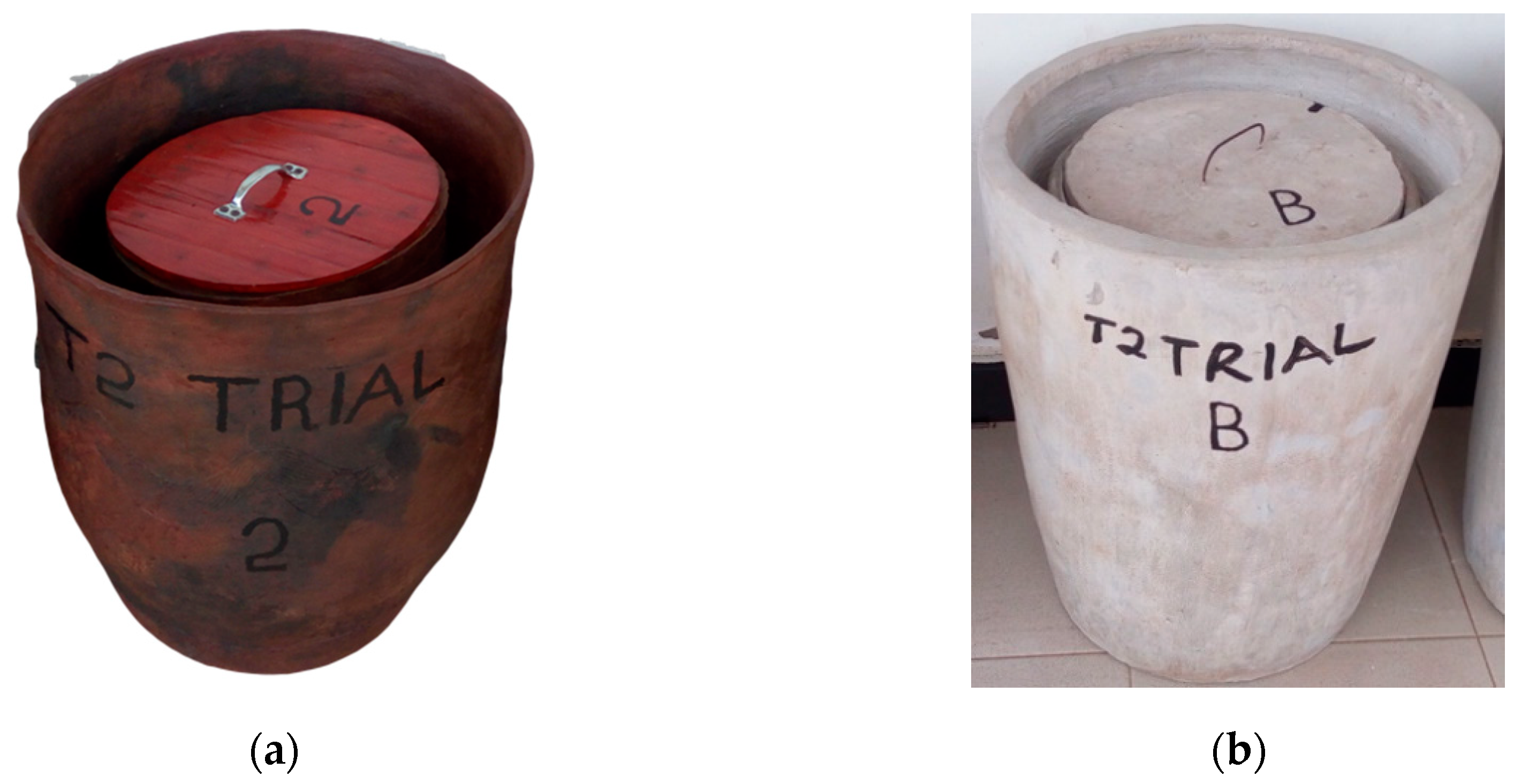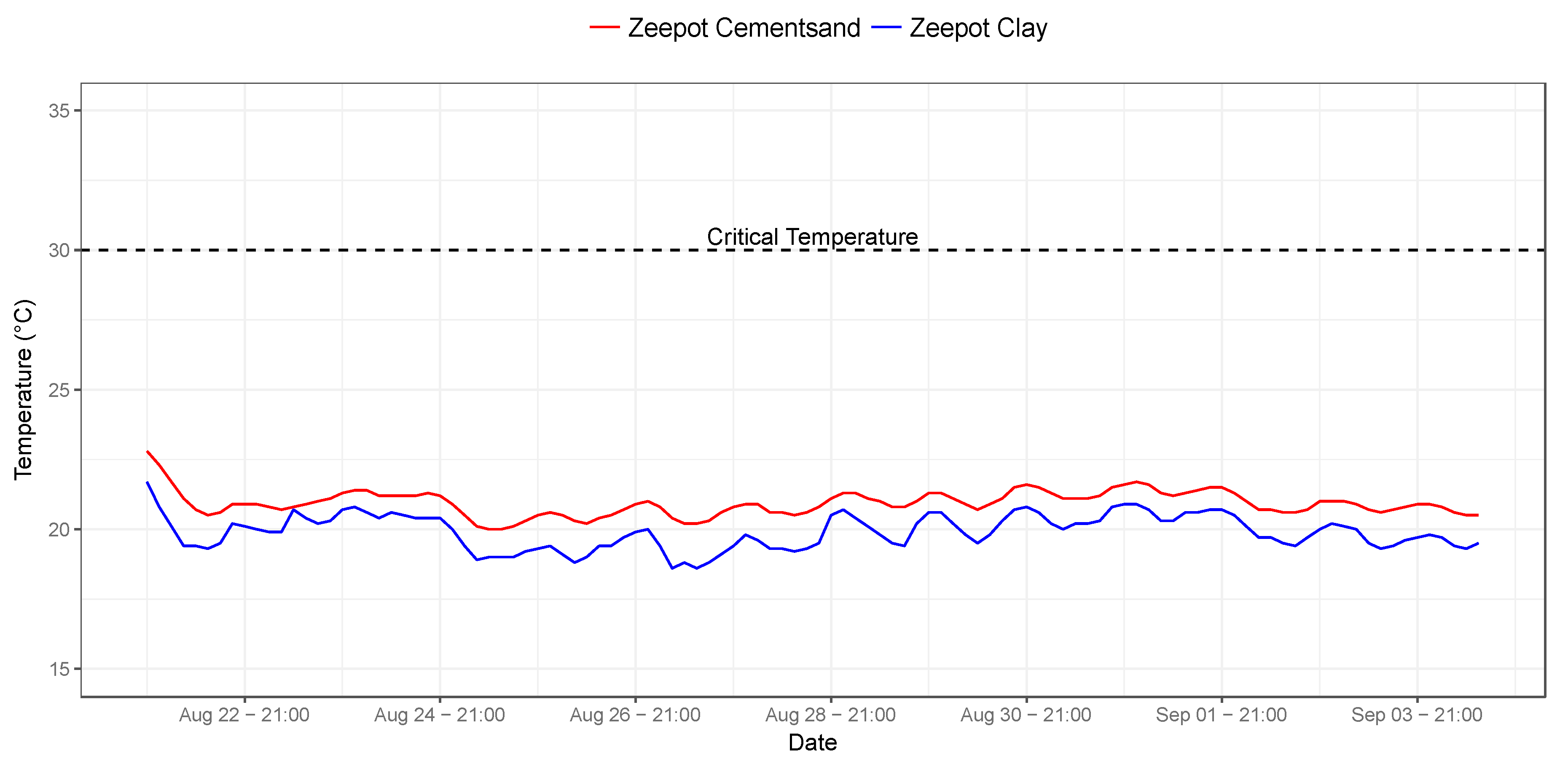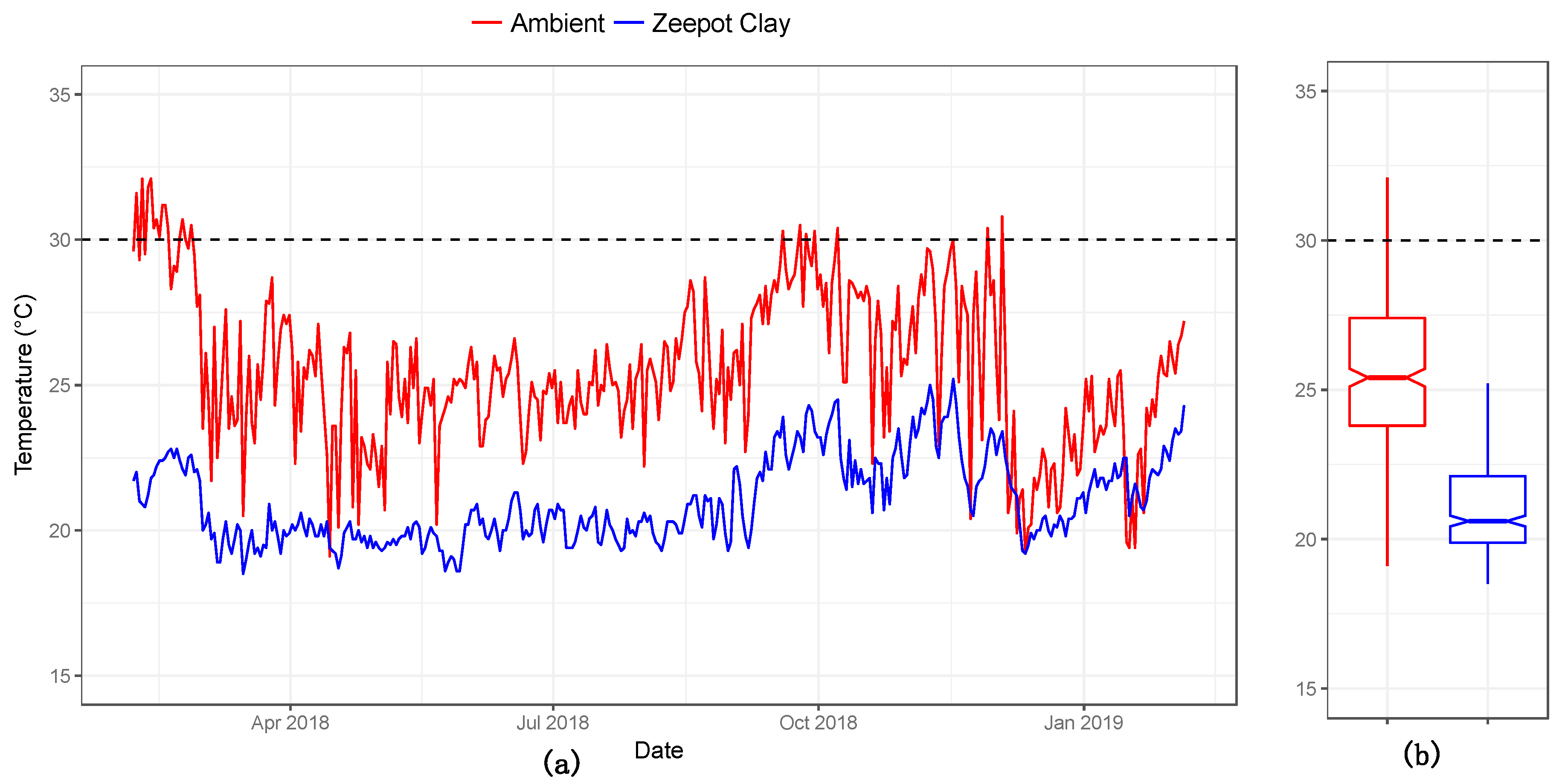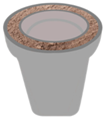Controlling Human Rabies: The Development of an Effective, Inexpensive and Locally Made Passive Cooling Device for Storing Thermotolerant Animal Rabies Vaccines
Abstract
1. Introduction
2. Materials and Methods
2.1. Phase I: PCD Design and Development
2.2. Phase II: Field Testing
2.3. Phase III: Refinement
2.4. Phase IV: Final Testing
3. Results
3.1. Phase I: PCD Design and Development
3.2. Phase II: Field Testing and Selection
3.3. Phase III: Refinement
3.4. Phase IV Final Testing
4. Discussion
5. Conclusions
Author Contributions
Funding
Acknowledgments
Conflicts of Interest
References
- Rashid, J.; Taiwo, O.O.; Ahluwalia, I.; Chungong, S. Disparities in Infectious Diseases among Women in Developing Countries. Emerg. Infect. Dis. 2004, 10, e24. [Google Scholar] [CrossRef]
- Mathers, C.D.; Boerma, T.; Ma Fat, D. Global and Regional Causes of Death. Br. Med. Bull. 2009, 92, 7–32. [Google Scholar] [CrossRef] [PubMed]
- Chan, M. Beyond Expectations: 40 Years of EPI. Lancet 2014, 383, 1697–1698. [Google Scholar] [CrossRef]
- Ozawa, S.; Clark, S.; Portnoy, A.; Grewal, S.; Stack, M.L.; Sinha, A.; Mirelman, A.; Franklin, H.; Friberg, I.K.; Tam, Y.; et al. Estimated Economic Impact of Vaccinations in 73 Low- and Middle-Income Countries. Bull. World Health Organ. 2017, 95, 629–638. [Google Scholar] [CrossRef] [PubMed]
- Dowdle, W.R. The Principles of Disease Elimination and Eradication. Bull. World Health Organ. 1998, 76 (Suppl. 2), 22–25. [Google Scholar] [PubMed]
- Andre, F.; Booy, R.; Bock, H.; Clemens, J.; Datta, S.; John, T.; Lee, B.; Lolekha, S.; Peltola, H.; Ruff, T.; et al. Vaccination Greatly Reduces Disease, Disability, Death and Inequity Worldwide. Bull. World Health Organ. 2008, 86, 140–146. [Google Scholar] [CrossRef] [PubMed]
- Breman, J.G.; Arita, I.; Unit, S.E.; World Health Organization. The Confirmation and Maintenance of Smallpox Eradication; World Health Organization: Geneva, Switzerland, 1980. [Google Scholar]
- McCarney, S.; Robertson, J.; Arnaud, J.; Lorenson, K.; Lloyd, J. Using Solar-Powered Refrigeration for Vaccine Storage Where Other Sources of Reliable Electricity Are Inadequate or Costly. Vaccine 2013, 31, 6050–6057. [Google Scholar] [CrossRef] [PubMed]
- Robertson, J.; Franzel, L.; Maire, D. Innovations in Cold Chain Equipment for Immunization Supply Chains. Vaccine 2017, 35, 2252–2259. [Google Scholar] [CrossRef] [PubMed]
- Chen, S.-I.; Norman, B.A.; Rajgopal, J.; Lee, B.Y. Passive Cold Devices for Vaccine Supply Chains. Ann. Oper. Res. 2015, 230, 87–104. [Google Scholar] [CrossRef]
- Lloyd, J.; Cheyne, J. The Origins of the Vaccine Cold Chain and a Glimpse of the Future. Vaccine 2017, 35, 2115–2120. [Google Scholar] [CrossRef] [PubMed]
- Dawoud, B. A Hybrid Solar-Assisted Adsorption Cooling Unit for Vaccine Storage. Renew. Energy 2007, 32, 947–964. [Google Scholar] [CrossRef]
- Haidari, L.A.; Brown, S.T.; Wedlock, P.; Connor, D.L.; Spiker, M.; Lee, B.Y. When Are Solar Refrigerators Less Costly than On-Grid Refrigerators: A Simulation Modeling Study. Vaccine 2017, 35, 2224–2228. [Google Scholar] [CrossRef]
- Gasperino, D.; Yildirim, O. Design and prototyping of a passive cold chain vaccine storage device for long hold times. In Proceedings of the Comsol Conference, Intellectual Ventures, Boston, MA, USA, 13–15 October 2011. [Google Scholar]
- Norman, B.A.; Nourollahi, S.; Chen, S.-I.; Brown, S.T.; Claypool, E.G.; Connor, D.L.; Schmitz, M.M.; Rajgopal, J.; Wateska, A.R.; Lee, B.Y. A Passive Cold Storage Device Economic Model to Evaluate Selected Immunization Location Scenarios. Vaccine 2013, 31, 5232–5238. [Google Scholar] [CrossRef]
- Lankester, F.J.; Wouters, P.A.; Czupryna, A.; Palmer, G.H.; Mzimbiri, I.; Cleaveland, S.; Francis, M.J.; Sutton, D.J.; Sonnemans, D.G. Thermotolerance of an Inactivated Rabies Vaccine for Dogs. Vaccine 2016, 34, 5504–5511. [Google Scholar] [CrossRef]
- R Development Core Team R: A Language and Environment for Statistical Computing; R Foundation for Statistical Computing: Vienna, Austria, 2019.
- World Health Organization (WHO); World Organization for Animal Health (OIE); Food and Agriculture Organization of the United Nations (FAO); Global Alliance for Rabies Control (GARC). Zero by 30: The Global Strategic Plan to End Human Deaths from Dog-Mediated Rabies by 2030; Geneva, Switzerland, 2018; Available online: https://apps.who.int/iris/bitstream/handle/10665/272756/9789241513838-eng.pdf?ua=1 (accessed on 29 July 2020).
- Wallace, R.M.; Undurraga, E.A.; Blanton, J.D.; Cleaton, J.; Franka, R. Elimination of Dog-Mediated Human Rabies Deaths by 2030: Needs Assessment and Alternatives for Progress Based on Dog Vaccination. Front. Vet. Sci. 2017, 4, 9. [Google Scholar] [CrossRef]
- Keja, K.; Chan, C.; Hayden, G.; Henderson, R.H. Expanded Programme on Immunization. World Health Stat. Q. Rapp. Trimest. Stat. Sanit. Mond. 1988, 41, 59–63. [Google Scholar]
- Nguyen, J.L.; Dockery, D.W. Daily indoor-To-Outdoor Temperature and Humidity Relationships: A Sample across Seasons and Diverse Climatic Regions. Int. J. Biometeorol. 2016, 60, 221–229. [Google Scholar] [CrossRef]
- Widdowson, M.-A. Implementing an Ebola Vaccine Study—Sierra Leone. MMWR Suppl. 2016, 65, 98–106. [Google Scholar] [CrossRef]
- Olsen, P.; Elliott, E. From the USPTO-Innovation Saving Lives: 2016 Patents for Humanity Awards. Technol. Innov. 2017, 19, 437–440. [Google Scholar] [CrossRef]
- Friend, M.; Stone, S. Challenging requirements in resource challenged environment on a time challenged schedule: A technical solution to support the cold chain for the VSV-Zebov (Merck) Ebola vaccine in Sierra Leone Guinea. In Proceedings of the 5th IEEE Global Humanitarian Technology Conference (GHTC), Seattle, WA, USA, 8–11 October 2015; pp. 372–376. [Google Scholar]





| Design Name | Zeepot Clay | Zeepot Cementsand | Coolbox Sand | Coolbox Sawdust | Coolgardie |
|---|---|---|---|---|---|
| Shape |  |  |  |  |  |
| Materials | Clay | Cement, sand | Wood, coolbox (Princeware), 6ltrs | Wood, coolbox (Princeware), 6ltrs | Wood, fabric, plastic |
| Manufacturing time (Days) | 7 | 7 | 4 | 4 | 5 |
| Production Cost (US$) | 11 | 30 | 17 | 17 | 26 |
| Absorbent | Sand | Sand | Sand | Sawdust | Fabric |
| Cooling media | Water | Water | Water | Water | Water |
| Estimated lifespan (years) | 7 | >10 | 2 | 2 | 1 |
| Ranking | 1 | 4 | 2 | 3 | 5 |
| Prototype | Location | Temperature Range in °C | Mean Temperature (SD) |
|---|---|---|---|
| Zeepot Clay | Indoor | 16.6–20.5 | 18.6 (0.8) |
| Outdoor | 16.5–22.0 | 19.1 (1.1) | |
| Zeepot Cementsand | Indoor | 16.9–21.6 | 19.3 (0.9) |
| Outdoor | 16.4–22.0 | 19.6 (1.2) | |
| Coolbox sand | Indoor | 16.5–21.4 | 18.9 (1.0) |
| Outdoor | 16.4–24.3 | 20.1 (2.1) | |
| Coolbox sawdust | Indoor | 16.8–21.5 | 19.3 (1.0) |
| Outdoor | 16.5–23.4 | 20.0 (1.8) | |
| Coolgardie | Indoor | 15.5–20.7 | 18.2 (1.2) |
| Outdoor | 15.1–22.7 | 18.9 (1.9) |
| Site (Village, District) | Prototype | Temperature Range in °C | Mean Temperature (SD) |
|---|---|---|---|
| Bokore, Bunda | Zeepot Clay | 20.7–24.5 | 22.8 (0.9) |
| Ambient temperature | 20.8–43.5 | 28.7 (5.0) | |
| Sirari, Tarime | Zeepot Clay | 18.9–23.3 | 21.0 (0.8) |
| Ambient temperature | 17.2–35.2 | 24.3 (4.9) | |
| Mugumu, Serengeti | Zeepot Clay | 18.5–23.4 | 20.4 (0.9) |
| Ambient temperature | 18.9–32.4 | 24.9 (3.3) |
© 2020 by the authors. Licensee MDPI, Basel, Switzerland. This article is an open access article distributed under the terms and conditions of the Creative Commons Attribution (CC BY) license (http://creativecommons.org/licenses/by/4.0/).
Share and Cite
Lugelo, A.; Hampson, K.; Bigambo, M.; Kazwala, R.; Lankester, F. Controlling Human Rabies: The Development of an Effective, Inexpensive and Locally Made Passive Cooling Device for Storing Thermotolerant Animal Rabies Vaccines. Trop. Med. Infect. Dis. 2020, 5, 130. https://doi.org/10.3390/tropicalmed5030130
Lugelo A, Hampson K, Bigambo M, Kazwala R, Lankester F. Controlling Human Rabies: The Development of an Effective, Inexpensive and Locally Made Passive Cooling Device for Storing Thermotolerant Animal Rabies Vaccines. Tropical Medicine and Infectious Disease. 2020; 5(3):130. https://doi.org/10.3390/tropicalmed5030130
Chicago/Turabian StyleLugelo, Ahmed, Katie Hampson, Machunde Bigambo, Rudovick Kazwala, and Felix Lankester. 2020. "Controlling Human Rabies: The Development of an Effective, Inexpensive and Locally Made Passive Cooling Device for Storing Thermotolerant Animal Rabies Vaccines" Tropical Medicine and Infectious Disease 5, no. 3: 130. https://doi.org/10.3390/tropicalmed5030130
APA StyleLugelo, A., Hampson, K., Bigambo, M., Kazwala, R., & Lankester, F. (2020). Controlling Human Rabies: The Development of an Effective, Inexpensive and Locally Made Passive Cooling Device for Storing Thermotolerant Animal Rabies Vaccines. Tropical Medicine and Infectious Disease, 5(3), 130. https://doi.org/10.3390/tropicalmed5030130






